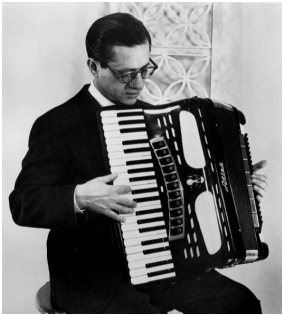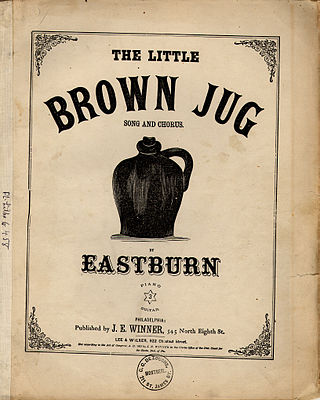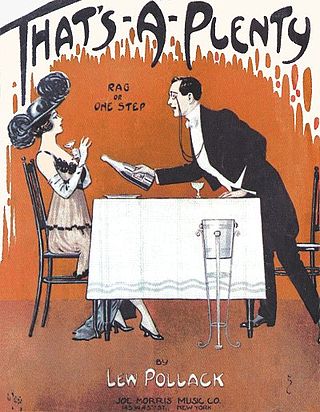Julius Baker was one of the foremost American orchestral flute players. During the course of five decades he concertized with several of America's premier orchestral ensembles including the Chicago Symphony and the New York Philharmonic Orchestra.

Benjamin Bernard Selvin was an American musician, bandleader, and record producer. He was known as the Dean of Recorded Music.

"Beer Barrel Polka", originally in Czech "Škoda lásky", also known as "The Barrel Polka", "Roll Out the Barrel", or "Rosamunde", is a 1927 polka composed by Czech musician Jaromír Vejvoda. Lyrics were added in 1934, subsequently gaining worldwide popularity during World War II as a drinking song.

"Singin' in the Rain" is a song with lyrics by Arthur Freed and music by Nacio Herb Brown. Doris Eaton Travis introduced the song on Broadway in The Hollywood Music Box Revue in 1929. It was then widely popularized by Cliff Edwards and the Brox Sisters in The Hollywood Revue of 1929. Many contemporary artists have since recorded the song.

John Serry Sr. was an American concert accordionist, arranger, composer, organist, and educator. He performed on the CBS Radio and Television networks and contributed to Voice of America's cultural diplomacy initiatives during the Golden Age of Radio. He also concertized on the accordion as a member of several orchestras and jazz ensembles for nearly forty years between the 1930s and 1960s.

Alexander Emil Caiola was an American guitarist, composer and arranger, who spanned a variety of music genres including jazz, country, rock, and pop. He recorded over fifty albums and worked with some of the biggest names in music during the 20th century, including Elvis Presley, Ray Conniff, Ferrante & Teicher, Frank Sinatra, Percy Faith, Buddy Holly, Mitch Miller, and Tony Bennett.

Squeeze Play is an Ultra High Fidelity monaural phonographic album which was released on the Dot Records label in 1956 (DLP-3024) featuring John Serry Sr. It includes an original composition by Serry, classical works, and popular music of the era. Ben Selvin serves as the musical director/producer for the album. The works were arranged by Serry and performed with his ensemble featuring two accordions, piano, guitar, bass, drum, vibes, and marimba.

RCA Thesaurus, a brand owned by RCA Victor, was a supplier of electrical transcriptions. It enjoyed a long history of producing electrical transcriptions of music for radio broadcasting which dated back to NBC's Radio Recording Division.
Anthony C. "Tony" Mottola was an American jazz guitarist who released dozens of solo albums. Mottola was born in Kearny, New Jersey and died in Denville.

"Little Brown Jug" is a song written in 1869 by Joseph Eastburn Winner, originally published in Philadelphia with the author listed as Winner's middle name "Eastburn".

"My Melancholy Baby" is a popular song published in 1912 and first sung publicly by William Frawley. The music was written by Ernie Burnett (1884–1959), the lyrics by George A. Norton.

"Chicago" is a popular song written by Fred Fisher and published in 1922. The original sheet music variously spelled the title "Todd'ling" or "Toddling." The song has been recorded by many artists, but the best-known versions are by Frank Sinatra, Ben Selvin and Judy Garland. The song alludes to the city's colorful past, feigning "... the surprise of my life / I saw a man dancing with his own wife", mentioning evangelist Billy Sunday as having not been able to "shut down" the city, and State Street where "they do things they don't do on Broadway".

"Nobody's Sweetheart", also known as "Nobody's Sweetheart Now" and "You're Nobody's Sweetheart Now", is a popular song, written in 1924, with music by Billy Meyers and Elmer Schoebel, and lyrics by Gus Kahn and Ernie Erdman. The song is a jazz and pop standard.

"Chinatown, My Chinatown" is a popular song written by William Jerome (words) and Jean Schwartz (music) in 1906 and later interpolated into the musical Up and Down Broadway (1910). The song has been recorded by numerous artists and is considered an early jazz standard.

"Oh, You Beautiful Doll" is a ragtime love song published in 1911 with words by Seymour Brown and music by Nat D. Ayer. The song was one of the first with a twelve-bar opening.

"Somebody Stole My Gal" is a popular song from 1918, written by Leo Wood. In 1924, Ted Weems & his Orchestra had a five-week run at number one with his million-selling version. Its Pee Wee Hunt and his orchestra version is also known in Japan, particularly in Osaka and surrounding area as the theme song used by Yoshimoto Kogyo for their theatre comedies at Namba Grand Kagetsu and other venues.
"If You Knew Susie" is the title of a popular song written by Buddy DeSylva and Joseph Meyer. It was published by Shapiro, Bernstein & Co. in 1925. The sheet music included ukulele tabs by Richard Konter. In the largely comic song, a man sings that he knows a certain woman named Susie to be much wilder and more passionate than most people realize.

"That's a Plenty" is a 1914 ragtime piano composition by Lew Pollack. Lyrics by Ray Gilbert were added decades later. Several popular vocal versions have been recorded, but it is more often performed as an instrumental.

In the early 1940s in jazz, bebop emerged, led by Charlie Parker, Dizzy Gillespie, Thelonious Monk and others. It helped to shift jazz from danceable popular music towards a more challenging "musician's music." Differing greatly from swing, early bebop divorced itself from dance music, establishing itself more as an art form but lessening its potential popular and commercial value. Since bebop was meant to be listened to, not danced to, it used faster tempos. Beboppers introduced new forms of chromaticism and dissonance into jazz; the dissonant tritone interval became the "most important interval of bebop" and players engaged in a more abstracted form of chord-based improvisation which used "passing" chords, substitute chords, and altered chords. The style of drumming shifted as well to a more elusive and explosive style, in which the ride cymbal was used to keep time, while the snare and bass drum were used for accents. This appealed to a more specialized audiences than earlier forms of jazz, with sophisticated harmonies, fast tempos and often virtuoso musicianship. Bebop musicians often used 1930s standards, especially those from Broadway musicals, as part of their repertoire. Among standards written by bebop musicians are Gillespie's "Salt Peanuts" (1941) and "A Night in Tunisia" (1942), Parker's "Anthropology" (1946), "Yardbird Suite" (1946) and "Scrapple from the Apple" (1947), and Monk's "'Round Midnight" (1944), which is currently the most recorded jazz standard composed by a jazz musician. An early 1940s style known as "jumping the blues" or jump blues used small combos, uptempo music, and blues chord progressions. Jump blues drew on boogie-woogie from the 1930s. Kansas City Jazz in the 1930s as exemplified by tenor saxophonist Lester Young marked the transition from big bands to the bebop influence of the 1940s. These divergences from the jazz mainstream of the time initially met with a divided, sometimes hostile response among fans and fellow musicians, especially established swing players, who bristled at the new harmonic sounds. To hostile critics, bebop seemed to be filled with "racing, nervous phrases". Despite the initial friction, by the 1950s bebop had become an accepted part of the jazz vocabulary. The most influential bebop musicians included saxophonist Charlie Parker, pianists Bud Powell and Thelonious Monk, trumpeters Dizzy Gillespie and Clifford Brown, and drummer Max Roach.
Thomas Henry Delaney was an American blues and jazz songwriter, pianist and singer, who wrote a number of popular songs, mainly in the 1920s. His work was recorded by many of the more fashionable singers and musicians of the period and later times, including Lillyn Brown, Lucille Hegamin, Original Dixieland Jass Band, Ethel Waters, Earl Hines, Count Basie, Bix Beiderbecke, Big Joe Williams, Clara Smith, Alberta Hunter, Clarence Williams, James P. Johnson, Woody Herman, Bukka White, Toots Thielemans, and Dinah Washington.















